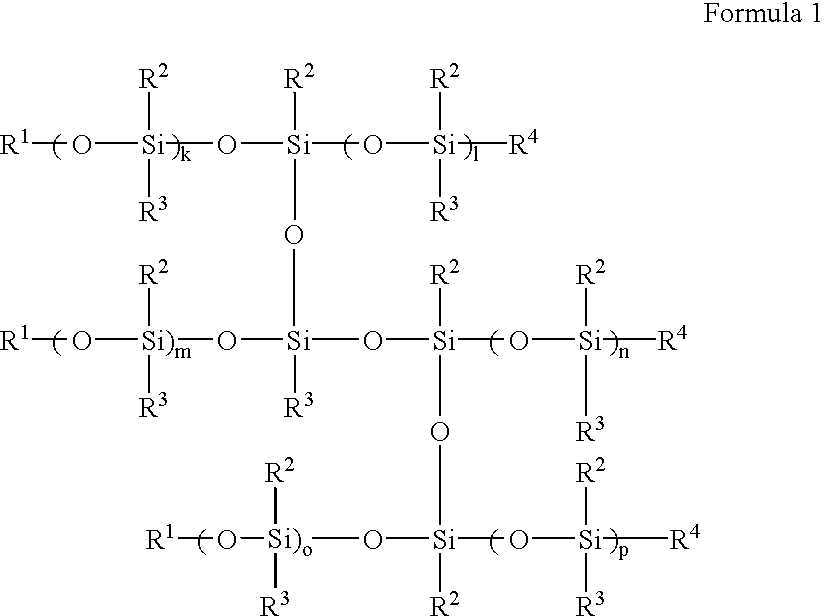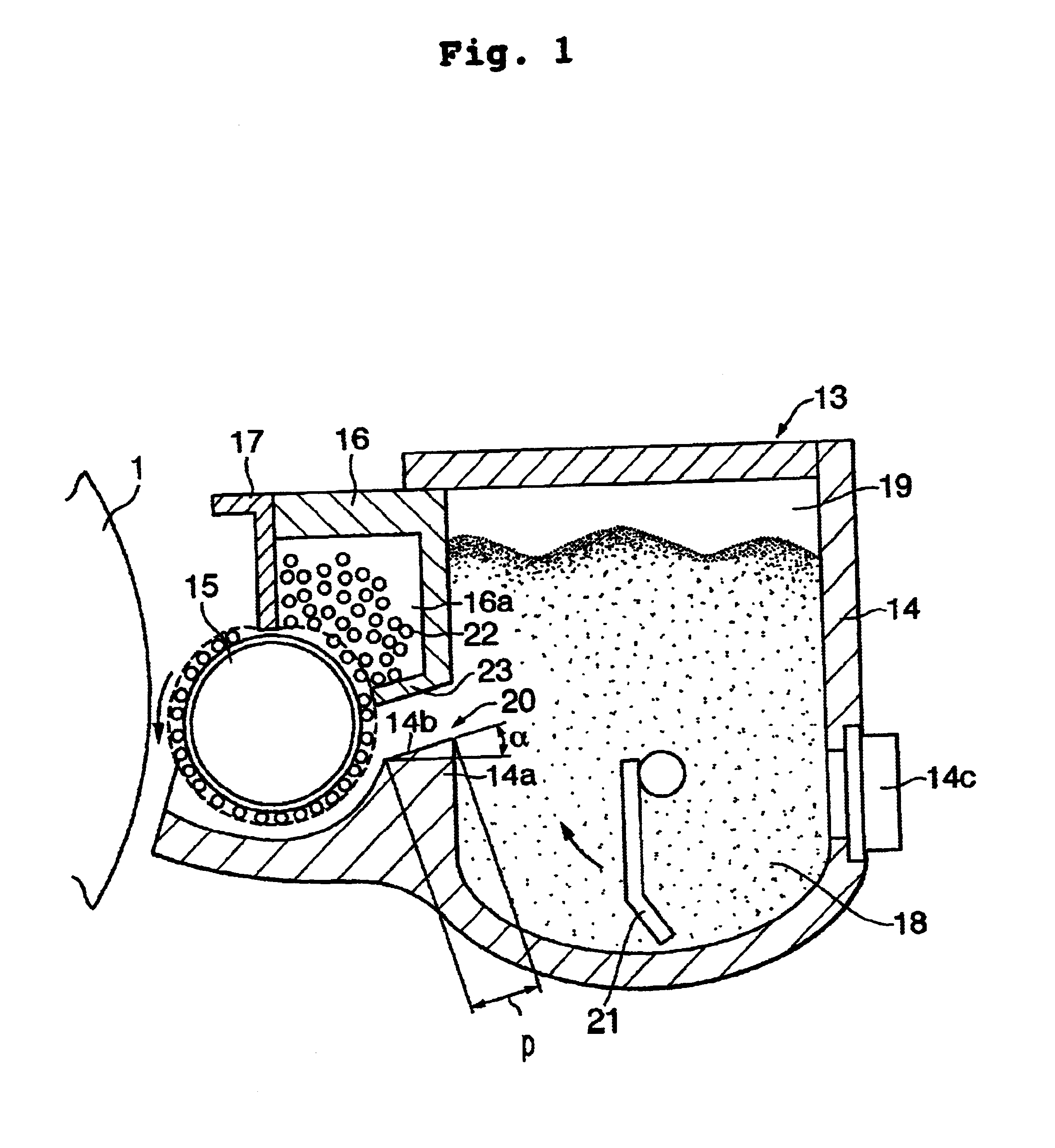On the other hand, there is a problem of an edge effect phenomenon in which the density around the center of an image becomes low compared to edge portions (i.e., corners) of the image.
In such level of quantity, it is very difficult to selectively place toner of a small particle diameter of 5 .mu.m or less in the peripheral portions on a latent image.
Accordingly, the toner becomes difficult to develop due to the magnetic bias effect, and, particularly in cases where toner having a toner particle diameter of 5 .mu.m or less is contained in the large quantity of 60 No.
%, the toner becomes excessively charged (overcharged), and developing power further deteriorates.
As a consequence, image density declines sharply, and this has constituted a problem.
When the toner is difficult to develop, moreover, toner builds up on the carrier surface, a phenomenon called spent occurs, and the useful life of the developer is sharply reduced, which has also constituted a problem.
However, although carriers coated in such a manner to exhibit outstanding charge characteristics, the threshold surface tension at the surface thereof is comparatively high, for such reason, the useful life thereof as a developer is not all that long, which has been a problem.
With this carrier, however, even though the problem of toner becoming spent does not readily occur due to the low surface tension, because the ethylene tetrafluoride copolymer is positioned on the most negative end in the frictional charge sequence, the carrier cannot be used when trying to electrify the toner to a negative polarity, which has been a problem.
Thus, by using a carrier the surface whereof is coated with a silicone resin, resistance to becoming spent is improved, but, when the amount of toner having a particle diameter of 5 .mu.m or less is great, the recent demand for longer useful life cannot be satisfied, which has been a problem.
However, there is no provision concerning particle diameter distribution in a range wherein most of the toner particles that determine image quality exist, and the effectiveness of such art is limited to single-component developing schemes wherein single-component developers are used.
Accordingly, with a single-component developer scheme, the advantage of being able to make the developing apparatus small is gained because there is no need to control toner density, but, because the number of toner particles in the development region is few compared to a two-component developer scheme, the amount of toner development toward the photoconductor is not sufficient, making it very difficult to cope with high-speed copiers, which has been a problem.
However, because the amount of developer cannot be made as great as in a conventional two-component developer scheme, in the case of a high-speed machine where the linear speed of the developing sleeve becomes high, the toner cannot be sufficiently charged, and the occurrence of ground fogging has been a problem.
Also, when an attempt is made to impart sufficient charging to the toner, it is necessary to make the controlling stress at the layer thickness controlling member stronger, and due to the heat generated by the mutual collisions of the developer particles, a film of toner is formed on the carrier surface, the so-called spent phenomenon ensues, carrier charge characteristics decline as the time of use lengthens, and toner scattering and ground fogging and the like develop, which has been a problem.
When developers to which large amounts of fluidity enhancers have been added are repeatedly used, however, the excessive fluidity enhancer in the toner adheres strongly to the latent electrostatic image carrier, leading to the problem of abnormal images being produced with streaks in them.
When the stirring stress on the developer is made large, moreover, in addition the spent phenomenon described earlier, the amount of charging in the toner becomes greater than necessary, resulting in the so-called charged-up phenomenon, which has also been a problem.
Thereupon, when an original document having a lot of image area is repeatedly copied, toner consumption becomes excessive, and the toner concentration in the developer exhibits extreme changes, so that image density declines, which has also been a problem.
Thus the toner density becomes unstable in places, and image density irregularities or fogging readily develop, which has been a problem.
With the art disclosed in that publication, however, because two toner supply members are used, the size of the developing unit becomes large and costs increase, which are problems.
More specifically, when the numbers of particles measuring 5 .mu.m or less becomes great, toner fluidity deteriorates, and the problem of toner uptake becoming destabilized is encountered.
When there are many large, coarse particles in the toner, moreover, the actual toner uptake amount decreases, and, particularly in cases where images that consume a large amount of toner are output, image density declines, and this too has been a problem.
However, although the addition of titanium oxide particles is effective in terms of environmental stability and image density stabilization, when a fluidity enhancer having an average particle diameter of 0.1 .mu.m or greater is used, the toner separates in the developing machine, and this has been a problem because it has resulted in ground fogging caused by toner fluidity deterioration and other factors detrimental to image quality.
%, the minute particles for faithfully reproducing the latent electrostatic image decrease, particularly when outputting images of high resolution, the problem of deteriorating reproducibility sometimes arises.
When the large, coarse particles are numerous, moreover, the amount of actual toner uptake decreases, and, particularly in cases where images that consume a large amount of toner are output, image density sometimes declines, which is a problem.
%, on the other hand, the fluidity as toner deteriorates, and toner uptake is not performed smoothly, so that image density irregularity due to toner density irregularity sometimes readily occurs.
%, the quantity of minute particles for faithfully reproducing the latent electrostatic image decreases, and particularly when outputting images of high resolution, the problem of deteriorating reproducibility sometimes arises.
%, on the other hand, the fluidity as toner deteriorates, and toner uptake is not performed smoothly, so that image density irregularity due to toner density irregularity sometimes readily occurs.
%, the quantity of minute particles for faithfully reproducing the latent electrostatic image decreases, particularly when outputting images of high resolution, the problem of deteriorating reproducibility sometimes arises.
%, on the other hand, the fluidity as toner deteriorates, and toner uptake is not performed smoothly, so that image density irregularity due to toner density irregularity sometimes readily occurs.
In the first aspect, when the weight-average particle diameter is less than 6.0 .mu.m, the electrical charge on the toner becomes high when it is used for a long time, and image density declines, and problems such as a decline in image density, particularly in a low-humidity environment, sometimes tend to arise.
When the weight-average particle diameter exceeds 8.0 .mu.m, on the other hand, the resolution of minute spots at 1200 dpi is not adequate, there is also much scattering to non-image portions, and image quality sometimes deteriorates.
In the second aspect, when the weight-average particle diameter is less than 6.0 .mu.m, the electrical charge on the toner becomes high when it is used for a long time, and image density declines, and problems such as a decline in image density, particularly in a low-humidity environment, sometimes tend to arise.
When the weight-average particle diameter exceeds 10.0 .mu.m, on the other hand, the resolution of minute spots measuring 100 .mu.m or less is not adequate, there is much scattering to non-image portions, and image quality sometimes deteriorates.
In the third aspect, when the weight-average particle diameter is less than 4.0 .mu.m, the electrical charge on the toner becomes high when it is used for a long time, and image density declines, and problems such as a decline in image density, particularly in a low-humidity environment, sometimes tend to arise.
When the weight-average particle diameter exceeds 10.0 .mu.m, on the other hand, the resolution of minute spots measuring 100 .mu.m or less is not adequate, there is much scattering to non-image portions, and image quality sometimes deteriorates.
When the amount mixed in is less than 0.1 parts by mass, the amount of toner charging is insufficient, so that is not practical, whereas, when 20 parts by mass is exceeded, the amount of toner charging is too large, and the electrostatic pulling force with the carrier increases, sometimes leading to a decline in developer fluidity and / or decline in image density.
When the amount mixed in is less than 0.1 mass percent, the effectiveness in correcting toner agglutination is sometimes weak, whereas when 2 mass percent is exceeded, such problems as toner scattering between fine lines, contamination of the interior of the machine, and the photoconductor being marred or worn tend to arise.
 Login to View More
Login to View More  Login to View More
Login to View More 


